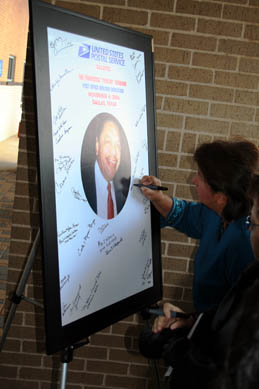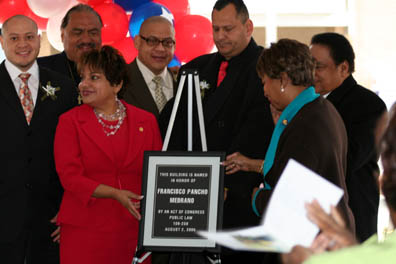Back to Headlines Frontpage
Contact me
Dallas, and I, Remember Pancho Medrano
A long list of dignitaries spoke on November 4 at the dedication of the Pancho
Medrano post office on Ferguson Street in East Dallas. Congresswoman Eddie Bernice
Johnson, who initiated federal legislation to honor Medrano, cried as she recalled
her lifelong friendship with Medrano. In the big 350-strong audience full of
political and civil rights activists, many of us re-assembled our own memories.
The first political act I ever did in Dallas was to help organize a rally to
defend gays in 1978. It was my job to find a speaker from organized labor. In
1978 in Dallas, I was skeptical that any union leader, or even any union member
in Dallas, would speak up for the rights of homosexuals, but I was wrong. Pancho
Medrano agreed as soon as I called him, and he did a fine job at the rally.
 Medrano
was an International Rep for the United Auto Workers. During the 1950s, International
President Walter Reuther had picked Medrano, already well known in Dallas as
a heavyweight boxer, union man, and a builder of progressive coalitions, to
represent the union in civil rights activities. In one particular way, Pancho
was head and shoulders above other leaders of his time, who tended to be nationalists
devoted only to their own ethnic group. Pancho worked for everybody's civil
rights.
Medrano
was an International Rep for the United Auto Workers. During the 1950s, International
President Walter Reuther had picked Medrano, already well known in Dallas as
a heavyweight boxer, union man, and a builder of progressive coalitions, to
represent the union in civil rights activities. In one particular way, Pancho
was head and shoulders above other leaders of his time, who tended to be nationalists
devoted only to their own ethnic group. Pancho worked for everybody's civil
rights.
I didn't know, until Pancho himself told me, about the many historic moments
he had shared. From Montgomery to Delano, Pancho was there. He saw Bobby Kennedy
get shot, and he defended Ladybird and Lyndon Johnson from a mob in Dallas.
He marched with Cesar Chavez and with "Tiger" Tijerina.
Even though it would be hard to figure out which of Pancho's many contributions
was most important, one nominee comes to mind. In 1974, he was the lead plaintiff
in a successful case against the infamous Captain A. Y. Allee and the Texas
Rangers. The Rangers were accused of excessive force against the Farmworkers
in the Rio Grande Valley. Pancho and others were roughed up, but they used the
occasion for a legal case that must have had a big role in ending the Ranger's
shameful history of racism and union busting.
I was fortunate, in 1979, to go to work in Medrano's old aircraft plant and
to join his old union local. His son, Frank, usually called "Pancho Jr,"
was active there. My first union activity was to campaign for Frank's election
as Vice President. As I began to take on more and more writing duties for the
local, I interviewed activists and retirees for the union newspaper and archives.
I interviewed Pancho and Frank several times. It was easy to find them, because
they were at progressive events that I attended, which were many. In 1983, Frank
got the local to pay for a Jobs with Justice bus to Washington DC to celebrate
the "I Have a Dream" speech by MLK. Both of UAW 848's Medranos made
the trip.
Pancho never missed the annual Martin Luther King parade. From 1990 on, I helped
organize union contingents. Even after Pancho aged too much to make the entire
march, he would join us for the last half mile or so, and march past the bandstand
with the unionists. I recall that the announcers would forget the name of our
Jobs with Justice contingent and just say, "And there's Pancho Medrano!"
There was a lot of applause, including from us marchers.
One of my prized photos shows Pancho, arms extended like Zorba the Greek, dancing
with happiness on Ross Avenue. The American union movement had finally reversed
its disastrous policy against immigrants' rights, and we were marching to show
our newly-approved solidarity with all workers.
Another time, we had a rally for Governor Ann Richards at the MLK Center in
Dallas. She started her speech, then interrupted herself: "Hey, there's
Pancho Medrano out there! Hello Pancho!" I understand that he was on such
friendly terms with people much higher than governors.
I often wish that the people who benefited from Medrano's activism had appreciated
him more when he was alive. Even his sisters and brothers in the union movement
could have done much more. He worked hard in politics, in civil rights, and
in union building, as did Frank until his untimely death around 1990. Pancho
"Senior" attended the March, 2002, retirees' luncheon at his old local,
where I photographed him for the last time. Right after that, even though deathly
ill, he rose up to vote in the primary election. A few days later, April 4,
we lost Pancho's physical presence, but not his inspiration.
Among Pancho's offspring are a present and former Dallas School
Board member and a present and a former City Council member, all in this photo
with the Congresswoman
There is more
about Pancho Medrano in the History section of this site
--Gene Lantz
Back to Headlines Frontpage
Contact me
 Medrano
was an International Rep for the United Auto Workers. During the 1950s, International
President Walter Reuther had picked Medrano, already well known in Dallas as
a heavyweight boxer, union man, and a builder of progressive coalitions, to
represent the union in civil rights activities. In one particular way, Pancho
was head and shoulders above other leaders of his time, who tended to be nationalists
devoted only to their own ethnic group. Pancho worked for everybody's civil
rights.
Medrano
was an International Rep for the United Auto Workers. During the 1950s, International
President Walter Reuther had picked Medrano, already well known in Dallas as
a heavyweight boxer, union man, and a builder of progressive coalitions, to
represent the union in civil rights activities. In one particular way, Pancho
was head and shoulders above other leaders of his time, who tended to be nationalists
devoted only to their own ethnic group. Pancho worked for everybody's civil
rights.